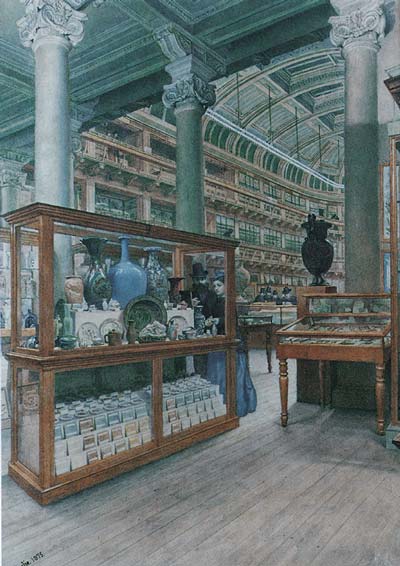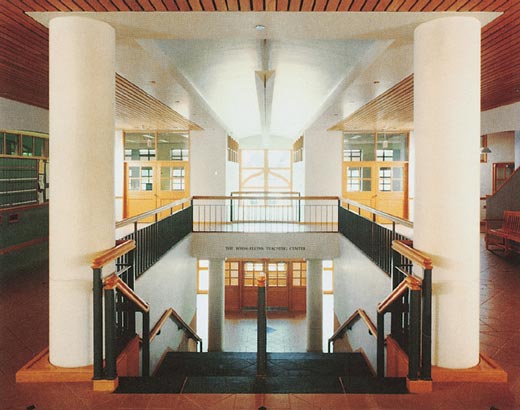
This Article From Issue
November-December 1999
Volume 87, Number 6
DOI: 10.1511/1999.42.0
The Architecture of Science. Peter Galison and Emily Thompson, eds. xviii + 573 pp. The MIT Press, 1999. $65.
The Architecture of Science confronts what have become increasingly incompatible intellectual positions and calls for action. From the late 1920s until the early 1970s, mainstream architects accepted a Modernist ideology that saw itself as the inevitable and final unfolding of the Enlightenment. Modernism fostered an inflexibly reductive attitude toward design, as well as hoary cliches about a clean, functional, mechanical architecture in service of freedom, egalitarianism, social order, hygiene and progress. Science, or at least its image, served as both role model and tool for positive action. Broad agreement seemed possible. In the past 30 years or so, under the often perplexing aegis of postmodernism, poststructuralism and deconstruction, the views of many critics and practitioners about the purposes and meanings of architecture shifted, following Jean François Lyotard's conclusion in 1979 that the Enlightenment's unified intellectual and scientific program is no longer viable. Scientific models have become less important, and in most American schools of architecture technical education has been de-emphasized. Paradoxically, many scientists and technologists now use architecture as a metaphor for their large-scale structures. One hears frequently of architectures of the cosmos, of computer systems or of the genetic code.
Yet neither computers nor cosmology are mentioned in this volume, nor are many other topics the ambitious title would warrant. The bulk is historical, but this is not a comprehensive history of the architecture that has housed science. Only one astronomical observatory is named. No 19th century university laboratories merit mention, nor does Menlo Park or Bell Labs. Other portions are more theoretical, asking whether architecture is a science and providing mostly historical perspectives. Two final sections address case studies, a molecular biology laboratory at Princeton and two big physics sites, Fermilab and the cancelled Superconducting Supercollider.
Among the authors only Antoine Picon, French historian of engineering and architecture, defines or distinguishes carefully between science, technology and engineering. It is even unlikely that contributors hold a common understanding of these categories, although Picon observes and approves of a broad tendency for historians of science, technology and architecture to meld their boundaries. The scholarship is atomistic, multiple centered, perhaps reflecting Lyotard's view of postmodern knowledge but more likely a result of this collection's origin—as papers from a 1994 Harvard University conference about architecture and its accommodations with science. Peter Galison, a 1994 MacArthur Fellow, introduces the 22 papers with no attempt at synthesis.
Architecture is an art of ordering as much as anything, and, as Erwin Panofsky once taught, its favored organizing methods often reveal deep intellectual patterns of its age. This volume's organization is neat but ultimately arbitrary. We may rummage through the essays to find other orders and to ponder the state of scholarship and thinking on this topic.
Emily Thompson discusses the American physicist Wallace Sabine's applications of acoustical analysis to architecture in the late 19th and early 20th centuries. Such advanced technology and current scientific understanding often were deployed in stylistically conservative buildings in Gothic or Renaissance styles. Thus Thompson differentiates as cultural antitheses a scientifically driven modernity, or modernization, and an ideologically driven modernism.
Many modernists expressed a kind of scientific faith through a stylistic nihilism. Three articles discuss the fortunes of the modernists' scientism.

From The Architecture of Science.
K. Michael Hays reviews the architecture and theory of perhaps the most reductive "scientific Marxist" architect of the 1920s, Hannes Meyer, who followed Walter Gropius as director of the Bauhaus in 1928. Meyer was eloquent about liberation made possible by new technologies and science, which he saw as equivalent. Alongside this, he devalued art as arbitrary and irrelevant to life. He believed forms must issue from technical requirements and submit to collective purposes. Although he thought scientific values underlay it, in retrospect his reductive program seems aesthetically driven. Michael Hays reiterates Meyer's views somewhat uncritically.
Moshe Safdie, architect of the laboratories for the defunct Superconducting Supercollider, explains his design philosophy as another formal determinism using biology as a model. He acknowledges a debt to D'Arcy Thompson's On Growth and Form and argues that as in biology so in architecture form is generated by a response to requirements and physical constraints. He notes that the vernacular architecture discussed and depicted in Bernard Rudofsky's Architecture Without Architects exhibits the same adaptive responses described by Thompson. The beauty of these forms results strictly from fitness to purpose, not from the artfulness of the maker. Safdie's analogy of biology and architecture seems weak, because the same building forms can respond well to different functional requirements. His premise assumes, incorrectly, that precisely defined functions yield unique forms. Also, vernacular architecture follows many formal constraints beyond functional adaptation. Traditions are as important and can survive for reasons unrelated to optimal performance.
The architectural historian Kenneth Frampton outlines a history of the "unfinished modern project, in the scientific sense" to reconstitute architecture as an applied science. He begins with Alexander Klein's efforts to find the most efficient minimal dwellings (1923–31) and takes us through a rapid synoptic tour including Hannes Meyer, the humanizing, regionalist reactions of Alvar Aalto and Richard Neutra, the bio-climatic design science of Victor Olgyay, the behavioral and perceptual methods of Sven Hesselgren, the geometric studies of Lionel March and Philip Steadman at the Cambridge Center for Built Form and Land Use Studies, Max Bill and industrial design at the Hochschule für Gestaltung in Ulm, and Buckminster Fuller and Konrad Wachsmann's efforts at industrializing building. Contemporary high-tech architects Richard Rogers, Norman Foster and especially Renzo Piano still carry this project forward. Frampton recognizes that architecture must integrate many scientific, technical and artistic discourses. But the critical collapse of ecosystems worldwide driven partly by escalating energy use suggests to him an ongoing role for scientific engagement in an architecturally constructed world.
Denise Scott Brown, practicing architect and theorist, offers a salutary response to unbridled faith in technical determinism. She addresses the monstrous intuitive complexity of architectural design, intensely integrative of many variables, most of them human and nonquantifiable, and others, like long-term conditions, intrinsically unknowable. She argues that scientific design methods have pointlessly tried to bypass this messy, nonquantifiable creative synthesis. They also often ignore the extensive analysis that architects perform once these apparently mystical intuitive processes have yielded a preliminary design. She sees profitable similarities between a description of work in a scientific laboratory in Lewis Thomas's The Lives of a Cell and studio training, the intense, time-consuming learning-by-doing that characterizes architectural education.

From The Architecture of Science.
Several authors claim that before the 18th century architecture was a theoretical scientific discipline. The architectural historian Alberto Pérez-Gómez invented this myth of an architectural Golden Age in his 1983 book Architecture and the Crisis of Modern Science. Architecture lost scientific status in the Enlightenment, to become an art with new embedded technical domains, such as structure, mechanical systems and programming. Here Pérez-Gómez outlines his vision of architecture and science once united under Platonic cosmology. He argues, following the philosopher Husserl, that Galileo's reduction of experience to quantity fractured the ancient unity and ushered in the modernity. Pérez-Gómez laments and resists this loss. Fearing a visionary new man, consumerism-driven, immortal, immaterial, intertextual, he believes a task of architecture is to keep science and technology from integrating into a coherent set of values. He embraces Alfred Jarry's whimsical science of "pataphysics," an ironic distancing from real science and technology akin to that of the artist Marcel Duchamp.
Antoine Picon, who rejects many of Pérez-Gómez's theses, agrees that architecture no longer provides models for our scientific conceptions of the world and that before the 18th century the various enterprises of knowledge were more closely connected. Scientists were interested in architectural problems and vice versa. Architects' creations encouraged Galileo's scientific speculation in Two New Sciences, and some architects, such as Simon Stevin, Claude Perrault and Christopher Wren, were also scientists. Perceptual-optical problems, analogies between architectural structures and classical anatomy, and relations between architectural typology and classificatory systems in natural history were part of an "intricate network of metaphors and analogies" linking architecture and science. In that classical age proportion was the central concern of Vitruvian architecture, as was that of science: The geometry of Perrault's Observatory of Paris had cosmic axial links and could be used as a scientific instrument. By the second half of the 18th century these relations had weakened and had only symbolic value. In the early l9th century, architecture and science already belonged to separate realms. Nonetheless Picon sees weaker but significant links that remain. Some are superficial, like the rationalist analogy of structure and organisms in life sciences, drawing together Georges Cuvier and Viollet-le-Duc. But there are deeper common attitudes, such as a transformation of classical Aristotelean substantial being to a post-Newtonian mathematics of operations on "elements" whose reality lies in their man-made definitions. More recently our technical artifacts have become so complex and extended that they no longer can be seen as isolated objects, like classical automata, but instead have become full-fledged environments in which we live. What circulates between science and architecture is still interesting, if less heroic than either modernists or the ancients expected.
In a loosely related argument, Peter Galison and Caroline Jones suggest structural similarities in the evolution of production sites of big science and of American art in the 20th century. Jackson Pollock's studio recapitulates alchemists' laboratories, but Andy Warhol's Factory was akin to post–World War II laboratories. Robert Smithson's Spiral Jetty of 1970 exhibits a decentralized, distributed site of production and authorship similar to that of major experiments at CERN.
This book exemplifies the problems inherent in the increasing popularity of conference proceedings. They may fulfill requirements for academic promotion and tenure but often fall short of traditional standards of scholarly coherence. The living value of a conference, the sharing of viewpoints and personal experiences, is absent in its publication. As in commercial strip developments, each component stresses its agenda at the expense of the whole. What remains often has transient value. The Architecture of Science exhibits contradictory viewpoints and interpretations that the editors could at least have noted and instructed authors to address directly. There are also plain errors of fact and papers that wander off the book's theme. Four papers on the Lewis Thomas Laboratory at Princeton tell the same story, absent the striking shifts of each retelling in Rashomon. Specific terminology can be defined precisely in one paper and used murkily in the next.
Architecture is not a science and never was. But there are innumerable points of contact between the sciences and this ancient art that still regulates much of our manmade world. The current fragmentation, uncertainty and self-preoccupation in architecture stands in a historically unprecedented relation to science, which appears to be moving toward an increasingly compelling integration of its master narratives. Unfortunately, The Architecture of Science does not help bridge an increasingly distant dialogue between science and architecture.
American Scientist Comments and Discussion
To discuss our articles or comment on them, please share them and tag American Scientist on social media platforms. Here are links to our profiles on Twitter, Facebook, and LinkedIn.
If we re-share your post, we will moderate comments/discussion following our comments policy.